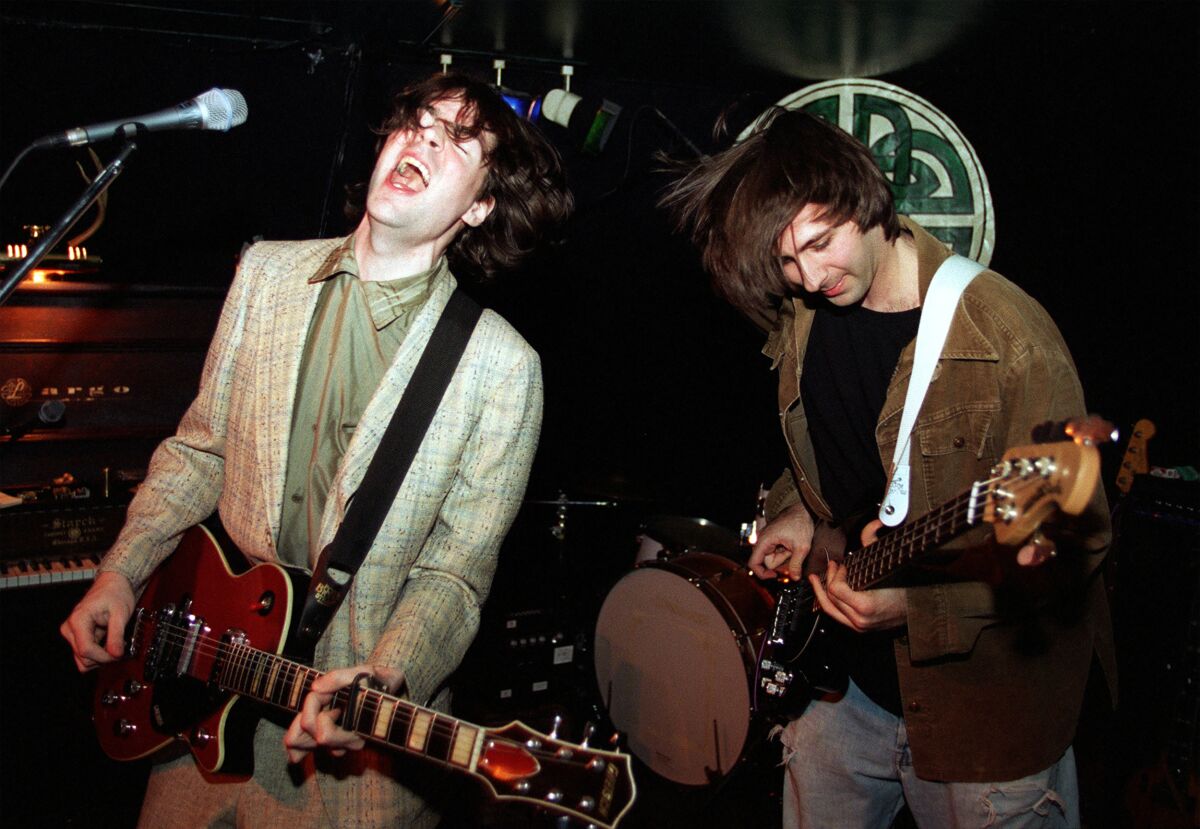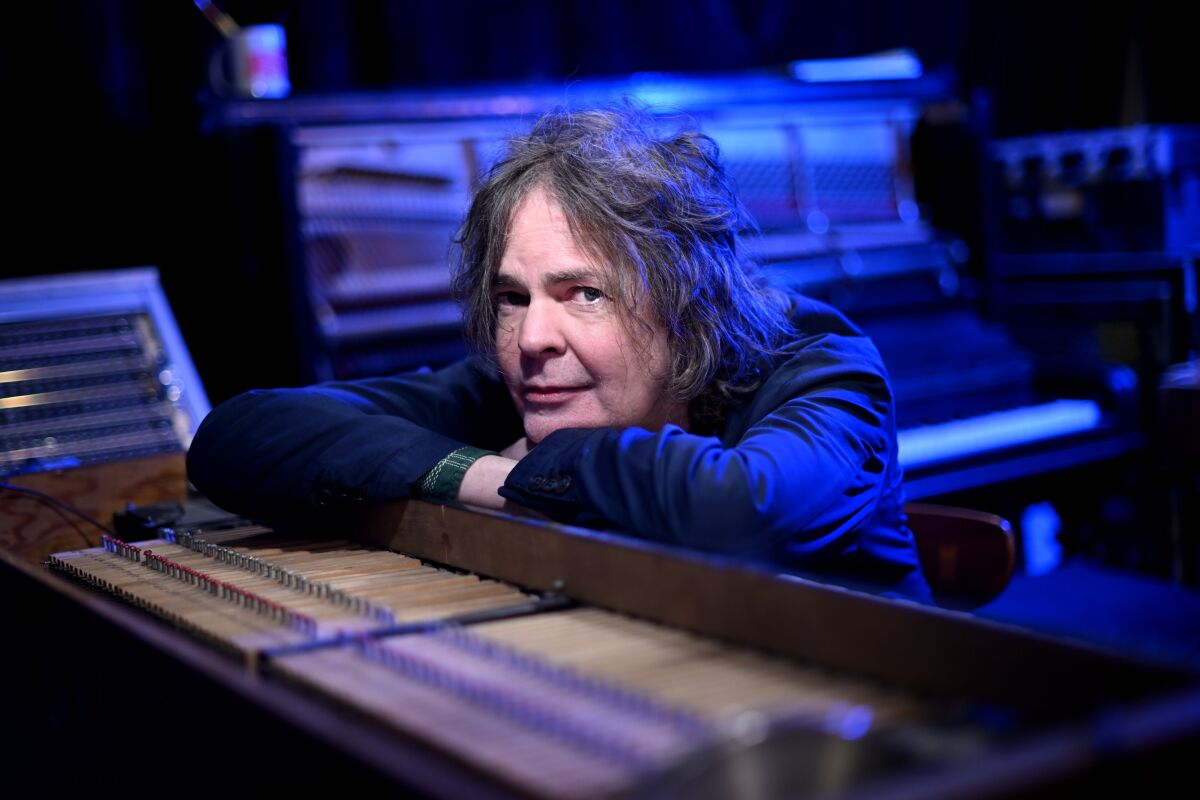Jon Brion used to look through liner notes with a fear of seeing his name. Actually, the name was OK — it was the list of a dozen or more instruments that inevitably appeared next to his name that he began to dread.
“You remember the old Jerry’s Deli menu, where it was like a loose-leaf binder you got handed?” he asks, invoking the venerable Studio City eatery to illustrate how he was identified on albums like Aimee Mann’s “Whatever,” much of which he produced and on which he’s credited as playing — deep breath here — pump organ, Mellotron, Chamberlin, glockenspiel, Optigan, vibraphone, piano, harmonium, Hammond organ, Indian harmonium, Cottage organ, B-3, celeste, toy piano, tack piano, Wurlitzer and marimba. “It was a zillion variations on the same thing: How do you want your pastrami or corned beef? And you’re like, I’m here because I’m hungry and it’s 3 a.m.”
The problem was that all these exotic-sounding devices were “basically just different keyboards,” as Brion puts it, and by mentioning each of them, the artists who hired him as a session musician — one of L.A.’s most in-demand in the late 1990s and early 2000s — were “stoking an idea that I don’t believe in and certainly wasn’t intending to put out there,” which was this: Jon Brion is the Man Who Can Play Anything.
Today the characterization still makes him wince. But although he says he asked folks to streamline his contributions, Brion’s legend only continued to grow thanks to his prolific studio work with the likes of Mann, Fiona Apple, Rufus Wainwright and Elliott Smith and to his regular Friday night gig at Largo, which became a kind of clubhouse for L.A.’s arty-brainy singer-songwriter scene. By 1999, not long after he’d scored Paul Thomas Anderson’s Oscar-nominated “Magnolia,” Brion had a deal with a major record label to release an album that was supposed to launch a solo career of his own.
That’s not what happened.
Instead, the label rejected Brion’s LP, titled “Meaningless,” telling him that his plaintive and witty songs had no prospects for radio play. Brion eventually started selling CDs through the internet — this was 2001, half a decade before Spotify’s founding — and at Largo and Amoeba Music in Hollywood, where his assistant would drop off copies by hand. Yet those few in the know, including some of Brion’s famous friends, came to view “Meaningless” as a lost classic.
“It was the holy grail — this unheralded work of genius that we other songwriters would measure each thing we did against,” says Rhett Miller, the Old 97’s frontman who tapped Brion to produce his 2002 solo disc, “The Instigator.” “Our little tribe at Largo regarded it as the perfect album.”
Now, more than two decades later, “Meaningless” is widely available for the first time on streaming services and in a new vinyl reissue through Jealous Butcher Records — and just as Brion, 59, is slowly preparing to revive his beloved Largo residency after a years-long break due to the pandemic.
Packed with indelible melodies and tightly honed turns of phrase — “I trust her to undermine my faith in her in time / I have every confidence that she’ll dismantle mine” — “Meaningless” frames Brion’s thoughts on heartbreak and disappointment with clever arrangements that showcase his lush but off-kilter production style: the thrumming double-time drums in “I Believe She’s Lying,” which he co-wrote with Mann; the tinkling music boxes and backwards guitars in a cover of Cheap Trick’s “Voices”; and, yes, the silvery whir of some obscure vintage keyboard in “Trouble,” which features backing vocals from Brion’s ex-girlfriend, actor-comedian Mary Lynn Rajskub, and which Smith was known to perform in concert before his death in 2003.
In its blend of tenderness and whimsy — not to mention its tangled feelings about the dream factory of show business — the music earns a place among cult-fave West Coast pop LPs such as Van Dyke Parks’ “Song Cycle,” Harry Nilsson’s “Nilsson Schmilsson” and “Sail Away” by Randy Newman, who like Brion has alternated his songwriting with composing for movies. (After “Magnolia,” Brion went on to score Anderson’s “Punch-Drunk Love,” Michel Gondry’s “Eternal Sunshine of the Spotless Mind” and David O. Russell’s “I Heart Huckabees,” among other films.) As with Newman, you wouldn’t say Brion has the world’s most powerful or flexible singing voice. But it’s got a yearning quality that suits the material.
Seated behind a recording console at his studio in Burbank on a recent evening, Brion laughs when asked what went through his head when he reencountered “Meaningless,” which he hadn’t heard in years before checking out the remastering job for the new release. “Honestly, it was a little better than I thought it would be. I came in here to give it a listen, sat in the chair over there,” he says, tilting a pint of Guinness toward a corner of the cozy room. The place is jammed with instruments, including a vibraphone he bought for $150 just after moving to L.A. in 1991, though he says this is just a fraction of the gear he owns; most of his stuff is in storage in a warehouse in the Valley, which he also calls home. Brion cuts a slightly more rumpled figure than he did back in the late ’90s, when he’d bounce among instruments on the Largo stage with a boyish sparkle in his eyes. These days he regards you slightly sideways, as though he’s judging whether you intend to let him down in some way.
Jon Brion outside his recording studio in Burbank. “To say the record company hated it,” he says today of “Meaningless,” “is really underselling their lack of enthusiasm.”
(Wally Skalij / Los Angeles Times)
Brion’s positive reaction to “Meaningless” came as something of a surprise to him given the album’s unsparing portrait of romantic woe — “For me, it’s like going through a box of old pictures you put a skull and crossbones over,” he says — and the degree to which he’d internalized the perception that the album was a failure. “I’ve been forced by the outside world to be suspicious of it,” he says. “But some of the songs, I’ll admit I was like, ‘Emotionally, that got its point across better than a lot of the people I was making records with at the time.’”
In Brion’s view, a record producer’s job often amounts to helping a singer dismantle a showy sense of presentation that can get in the way of true expression. Told that his singing on “Meaningless” feels almost entirely free of artifice, he appears close to tearing up.
“You just said the only thing that counts,” he says.
Born in New Jersey and raised in Connecticut, where his father directed the marching band at Yale University, Brion discovered the possibilities of multitrack recording as a teenager thanks to a friend of his dad’s who had a studio in his house. “Ever since I was 13 I’ve had headphones on,” he told Tape Op, a recording magazine, in 2000. After dropping out of high school, Brion moved to Boston in the late ’80s and played as a touring member of Mann’s new wave band ’Til Tuesday. Once in L.A., he quickly found session work for acts like Jude Cole and psych-pop outfit Jellyfish, whose former guitarist Jason Falkner formed a group called the Grays with Brion and two other songwriters, Buddy Judge and Dan McCarroll. The Grays flamed out after a single album and Brion busied himself with studio work — that’s him playing lead guitar on the Wallflowers’ No. 1 rock hit “One Headlight” — and with the Largo gig, which went viral in an age before social media.
“Every Friday night, the place would be full of directors and movie stars and label execs,” says Miller, one of countless guests who regularly joined Brion at the tiny club (then on Fairfax) in a head-spinning program that mixed originals and far-flung covers with stretches of pop improvisation in which Brion would, say, perform “I’ve Got You Under My Skin” to the tune of “Strawberry Fields Forever.”

Jon Brion, left, and Greg Collins perform at Largo in 1997.
(Alan J. Duignan / Los Angeles Times)
Mann remembers asking Brion to play on a record of hers, for which he volunteered to take up the pedal steel — “an unbelievably complicated instrument he’d never touched,” she says. “So we rented one, and in three days he taught himself how to play and did this magnificent solo. It was like watching an AI learn.”
Brion’s original plan for “Meaningless” was to dial down the Man Who Can Play Anything vibe, which had already started to wear on him. “I had one intention, which was that I wasn’t producing and I wasn’t playing all the instruments. So I got a friend to produce,” he says, referring to Ethan Johns, “and I called people around town I thought were soulful musicians,” among them drummer Jim Keltner, keyboardist Benmont Tench and guitarist Greg Leisz. “I put a studio in the basement where I was living and made a record where all I did was sing and play acoustic guitar. And to say the record company hated it is really underselling their lack of enthusiasm.”
Though he doesn’t identify either by name, Brion offers a lengthy account of his back-and-forth with the label, an Atlantic Records subsidiary called Lava, and its founder, Jason Flom. In Brion’s telling, the label was vague about why it didn’t like “Meaningless” and what it wanted him to change; he’d send execs new songs, then wait months for feedback, only to be asked why they hadn’t received anything from him. Finally, while Brion was in the studio producing Apple’s “When the Pawn…” album, the label told him, “Just hand something in and we’ll put it out,” he says. He asked Apple for 10 days off and banged out a bunch of tunes on which he played everything, keeping only “Trouble” from the sessions with Johns. Lava, then riding high with hit records by Sugar Ray and Matchbox Twenty, still said no.
Flom, who describes seeing Brion’s freewheeling Largo show as “a revelation,” tells The Times he doesn’t recall the back-and-forth after the album was delivered. But he does remember the conversation that led to Brion’s signing with him. “I said something along the lines of, ‘You could make the most critically acclaimed album in the world in your sleep. Or, if you chose to, you could make something that would still be beautiful but commercially successful.’”
What Brion eventually made “was going to be a struggle for a major label,” says Flom. “I didn’t think we’d be able to do it justice, and I thought he would fare better on an indie.”
Asked how big a blow Lava’s pulling out was, Brion shrugs. “I was disappointed, but my life was fine,” he says. (The company gave Brion ownership of the album, which is how he was able to arrange a limited release through his Straight to Cut-Out label.) He kept occupied with production work on “When the Pawn…,” Robyn Hitchcock’s “Jewels for Sophia” and Mann’s “Bachelor No. 2 or, the Last Remains of the Dodo,” which Mann released herself in 2000 — the year of NSYNC’s “No Strings Attached” and Eminem’s “The Marshall Mathers LP” — after her major label, Geffen, said it didn’t hear a radio hit and declined to put it out.
“The idea of the creative, interesting, cult-figure-y singer-songwriter — it just wasn’t a thing in the major-label system at that time,” says Mann.

Jon Brion and Fiona Apple perform at a benefit concert for Hurricane Katrina relief in 2005.
(Christopher Polk / FilmMagic via Getty Images)
Brion got even busier as a sideman and producer after “Meaningless,” flitting between work with Tom Petty, Peter Gabriel, Marianne Faithfull, Badly Drawn Boy, the Crystal Method, Lisa Marie Presley and jazz pianist Brad Mehldau. A 2003 profile in the New York Times Magazine reported that Brion’s “manager fields calls from industry heavyweights like Clive Davis requesting Brion to produce his latest ingénue.” (“I was never Clive’s first call,” Brion says today.)
As much work as he did, he turned down even more, according to Largo’s owner, Mark Flanagan, who informally managed Brion’s career at the time. “So many of the artists of the day — Jewel, John Mayer — they wanted him to do stuff,” Flanagan says. “But Jon saw the writing on the wall: ‘That’s a factory, I don’t want to be part of that.’ He was holding out for the really interesting stuff.”
Mann, who once dated Brion in addition to collaborating with him, says it’s “emotionally hard for him to finish things” — be it a song or an album — “because the fun for him seems to be in generating ideas. And as soon as you make a decision about the ideas you’ve generated, then that’s over.”
There’s a purity to Brion’s mindset, as though he takes personally the notion that art can be corrupted by commercial ambition or the hunger for prestige. (He says he could always tell when someone wanted to work with him because they’d reached a point where they wanted to be taken seriously.) Which is why it makes sense that his highest-profile projects over the last few years — beyond his film scores for Greta Gerwig’s “Lady Bird” and Disney’s “Christoper Robin” — have been among his least expected.
In 2005 he worked closely with Kanye West on the rapper’s “Late Registration,” which led to collaborations more recently with R&B and hip-hop stars including Beyoncé, Frank Ocean, Janelle Monáe and Mac Miller. Brion pieced together Miller’s 2020 “Circles” album from recordings Miller left behind when he died from an accidental drug overdose in 2018.
“However sharp you think he was, he was even smarter,” Brion says of Miller, who used to drop by Brion’s studio for long talks about where he wanted his music to go. The songs on “Circles” layer Miller’s philosophical ramblings over ruminative grooves that blend soul, rap and psychedelic rock; Ocean’s “Blonde” has passages of heart-stopping beauty like the ballad “Self Control,” in which Brion’s strings come in at precisely the right moment.

“Committee decisions and art — generally not good,” says Jon Brion.
(Wally Skalij / Los Angeles Times)
Is Brion fond of the modern record-making practice by which eight or nine writers and producers participate, often remotely, in the completion of a given track? “It’s no fun,” he says. “Committee decisions and art — generally not good.” Yet Beyoncé, for whom he devised orchestral arrangements for 2016’s “Lemonade,” “is doing the work,” he says. “Zillion people on every song, recorded in endless places by endless engineers. But she gives a damn. She finished that record while she was rehearsing for her tour in a stadium somewhere. They set up a Pro Tools rig for her in the locker room, and she went in and finalized the mixes between dancing multiple hours a day. If there’s a good version of careerist, that’s it.”
In a funny way, Brion’s plans for the return of his Largo show mirror these shifts in his field. Back in the day he’d use looping technology to create a kind of one-man-band effect, building songs onstage in real time using different instruments. “Now the entire world is doing that,” he says, not least the stadium-touring Ed Sheeran, which pushed Brion to explore more novel approaches. “And what I found myself wanting to do right as the pandemic hit was get a large ensemble,” he notes with a bitter chuckle.
Flanagan, who moved Largo from its original location to a bigger space on La Cienega Boulevard in 2008, was hoping the COVID situation would be such that Brion could make his comeback for the club’s final date of 2022; instead, the owner has been canceling shows lately as performers have begun testing positive again.
Brion, who’s now tentatively set to restart the residency sometime early in 2023, didn’t want to reveal too much about what he’s cooking up. “To me, what’s missing from music is probably a very 19th century idea, except it’s not making 19th century music,” he says. “So, you know, I have a thing in mind.”


Comments are closed.